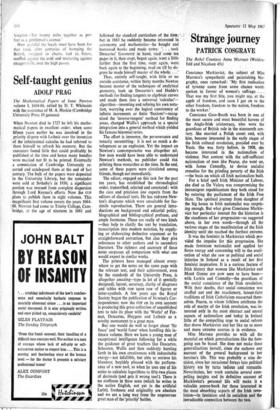Self-taught genius
ADOLF PRAG
The Mathematical Papers of Isaac Newton volume I, 1664-66, edited by D. T. Whiteside with the assistance of M. A. Hoskin (Cambridge University Press 10 guineas) When Newton died in 1727 he left his mathe- matical papers in excellent order; when some fifteen years earlier he was involved in the priority dispute with Leibniz over the invention of the infinitesimal calculus he had referred to them himself to refresh his memory. But the executors found little that could profitably be published at the time and hence many bundles were marked not fit to be printed. Eventually a commission of Cambridge University re- , sorted and catalogued them at the end of last century. The bulk of the papers were deposited in the University Library, but the remainder were sold at Sotheby's in 1936; a significant portion was rescued from complete dispersion through Lord Keynes's efforts. Now the cur plans to publish them in eight volumes. This -magnificent first volume covers the years 1664- 166. Newton had come to Trinity College, Cam- ' bridge, at the age of nineteen in 1661 and followed the standard curriculum of the time; but in 1663 he suddenly became interested in astronomy and mathematics—he bought and borrowed books and made notes : `. . took Descartes' Geometry in hand, read some ten pages in it, then stopt, began again, went a little farther than the first time, stopt again, went back again to the beginning, read on till by de- grees he made himself master of the whole....'
Thus, entirely self-taught, with little or no outside assistance, within thirty months Newton became master of the techniques of analytical geometry, took up Descartes's and Hudde's methods for finding tangents to algebraic curves and made them into a universal 'calculus'— algorithm—inventing and refining his own nota- tion, worrying over the logical consistency of infinite increments or finite 'fluxions'—recog- nised the 'inverse-tangent' method for finding areas, changed Wallis's approach to a special integration into a general method which yielded his famous binomial series.
The effort is immense, the perseverance and tenacity unremitting: it is not so much a de- velopment as an explosion. Yet the impact on Newton's contemporaries was altogether nil; few men would have been able to understand Newton's methods, no publisher could risk printing these researches at the time. In the end, some of these papers were circulated among friends, though not immediately.
The editor, engaged on this task for the past ten years, has established the chronological order, transcribed, selected and annotated: with the care and precision one expects from the editors of classical texts. He has redrawn New- ton's diagrams which were unsuitable for fac- simile reproduction. There are general intro- ductions on background and editorial policy, biographical and bibliographical prefaces, and ample footnotes. These are really of two kinds —they help to clarify the text by translation, transcription into modern notation, by supply- ing or elaborating deductive argument or by straightforward correction, but also they give references to other authors and to secondary literature. The richness and accuracy of these notes surpasses all comparison with what one would expect in similar works. .
The printers have managed almost every- where to get the notes on the same page with the relevant text, and their achievement, even by the standards of the University Press, is altogether amazing—type (a lot of it specially designed), layout, accuracy, clarity of diagrams and tables with row upon row of figures or letter-symbols. A few years ago the Royal Society began the publication of Newton's Cor- respondence; now the CUP on its own account is producing this great collection of unpublished text to take its place with the 'Works' of Fer- mat, Descartes, Huygens and Leibniz as a worthy monument to a great man.
But one would do well to forget about 'Sir Isaac' and 'world fame' when handling this in-
timate volume. Here we have a young man of
exceptional intelligence following for a while the guidance of great teachers like Descartes, Schooten, Wallis and then suddenly bursting forth in his own creativeness with indomitable energy—not infallible, but able to retrieve his blunders; boyishly pleased with the perform- ance of a new tool, as when he uses one of his series to calculate logarithms to fifty-two places of decimals (and gets it wrong too!). There is no stuffiness in these texts (which he writes in the native English, not yet in the artificial
Latin), freshness and originality are absolute and we are a long way from the ungenerous great man of the 'priority' battles.






























 Previous page
Previous page